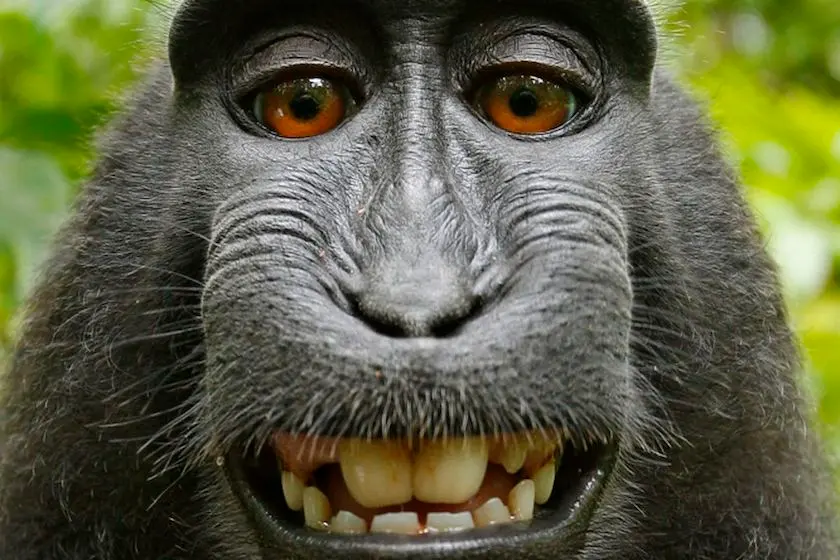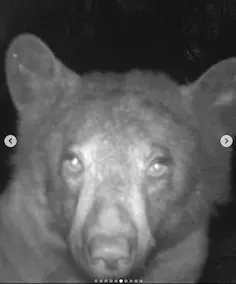Why can't the selfie monkey claim copyright on its photo?
How does copyright work for animals and why can't the selfie monkey claim copyright on its own photo? Read here how copyright, as part of intellectual property rights, works for humans but not for animals.

Is it possible for a monkey to obtain copyright on a selfie it took itself? Almost everyone who regularly surfs the internet and social media has seen the above selfie of the monkey and had a good laugh about it. The creature had grabbed someone's camera, put on its most charming smile, and taken the above photo. Nice story. But, as is often the case with too good stories, it also went a bit differently in this case, and this monkey business also had a legal sequel regarding the copyright on the selfie. Twice there have been lawsuits over the copyright of the monkey's selfie. How does this work?
Who owns the copyright on the monkey's selfie?
The lawsuits revolved around the question of whether it's possible for an animal to possess the copyright to a photo. Copyright belongs to the collection of so-called intellectual property rights (IP). This is also called IP or IPR, short for "Intellectual Property Rights". So what was the story behind the monkey's selfie? The photographer, from whom the camera was taken, was not an amateur but a professional nature photographer wh had ventured into the jungle of Indonesia with his photographic equipment to follow the group of macaques and create a photo report. It concerned a group of so-called Crested Macaques (Macaca Nigra) that inhabit the island of Sulawesi (Celebes). Crested macaques, also known as black macaques, belong to the same genus as the famous rhesus monkeys that are widely used in medical scientific research. Interesting in this respect is that the Rhesus monkey gave its name to the Rhesus factor in our blood (sorry, i am a medical biologist :-)).
Also, our grinning monkey in this story belonged to the group of Crested Macaques that were being followed by the photographer (his name is David Slater). He discovered that the monkeys had a keen interest in his equipment, and at one point, they actually got hold of a device and accidentally took some shots with it. However, these shots were not sharp, there was nothing special about them, and therefore, the shots were unusable.
However, this did give Slater the idea to set up a camera on a tripod and adjust it in such a way that selfies could be taken up close. And it worked. One of the monkeys, later named Naruto, showed great interest in the camera and managed to press the shutter button several times while also looking into the lens. And there were indeed some successful shots. Slater was delighted, and Naruto disappeared back into the jungle.
A lawsuit over the copyright of the monkey selfie
Then the copyright story really began. Upon returning home to England, the photographer sold a license for the selfie to a News Agency with the intention of making a profit from Naruto's self-portrait. He had, of course, made expenses during the trip, and the macaques had damaged part of his equipment. However, various companies and websites began printing and using the selfie online without compensation because they believed that the photographer could not claim copyright on Naruto's selfie at all. They thought the photo belonged to nobody and fell into the so-called public domain. So, everyone could use it. Wikipedia also included the monkey's selfie in the description of the Macaca Nigra, depicted at the at the bottom of the page.
To make matters worse, Slater himself was sued by an animal rights organization, PETA (People for Ethical Treatment of Animals). They demanded that all income from the photo be transferred to the organization, earmarked for further protection of the macaques on Celebes. They acted on behalf of the monkey and believed that the rights to the selfie belonged to Naturo.
How does that work? On our page about the background of copyright, it is explained that according to copyright law, someone (!) gets the right to their work when it has a concrete and original form. By originality, it means an own intellectual creation that expresses his or her personality. However, this only applies to creations made by humans. Therefore, the selfie taken by the monkey cannot be protected by copyright. Naturo the monkey also cannot claim copyright because it is not a natural person according to copyright law. So the court ruled that the monkey cannot claim copyright but that this right also does not belong to the photographer.
Thereupon, PETA appealed, making it even more complicated. This appeal addressed, among other things, whether PETA was entitled to represent the monkey and what the harm would be to the animal if it were not recognized as the rightful owner. Ultimately, this legal battle led to a settlement.
The conclusion is that this case not only resulted in a good story but also led to the realization that copyright law stipulates that only works created by humans can be protected. A human cannot claim copyright on Naruto's selfie because it was not made by a human. So neither the monkey nor the photographer can claim the right to the selfie. And that means, in principle, that the copyright of the photo belongs to no one and thus falls into the public domain. In other words, anyone who wants to can freely use the above photo (including me :-)). Wikipedia saw that correctly. The best result of this is, of course, that worldwide attention has been drawn to the vulnerable situation of the almost extinct species Crested Macaque, which only occurs in Sulawesi. Thanks to the real hero of this story: Naruto.
And yep, we have a CopyCat, or actually better: a CopyBear. A black bear from an American nature park in Colorado has taken more than 400 photos with one of the 9 cameras installed to monitor wildlife. In this way, the organization managing the nature parks tries to observe the animals and learn more about them without researchers having to venture deep into the woods. So here too, this photo is not subject to copyright and can be freely copied. So that's what we did below.

UPDATE: September 11, 2024: The dispute continues.... Several newmsmedia report that David Slater, the photographer behind the famous monkey selfie, is considering a new legal battle over the image. Despite his efforts and costs to capture the photo, Wikimedia (the media company of Wikipedia) refuses to remove it from its open-copyright collection. So, you can still find it on the Wikipedia page about the Macaca Nigra (see link above). Slater argues that he spent significant time, money, and equipment to take the shot, including a £2,000 trip and £5,000 worth of gear. However, Wikimedia claims no one owns the copyright, as a monkey cannot hold rights to an image. Slater believes a court case might be necessary to resolve the issue of ownership, as the authorship of the photo remains in dispute.
